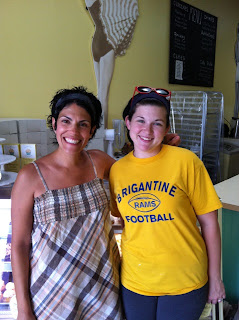We just got back from a few days in Ocean City, NJ, where there was plenty of sun, the beach, and a
ton of eating. Looking back at my pictures, I realize that most of them are of food. Well, not all....
 |
| Photo by Ryan Schneider |
|
This is where we parked ourselves for the better part of the trip; that is, when we weren't eating. And as I mentioned, there was a lot of eating. I've always been a fan of Jersey food. I just think there's plenty to love about it, from the freshness of the fruits and vegetables to the reliability of some of the staples, like pizza. I learned to love pizza in New Jersey. My mother made it every Friday night, and still does, and my brother and I would walk around the corner whenever we were tired of playing and had 75 cents to spend on a slice. It was always just the right thing at the right time, and I never got tired of it. So when I heard about All Natural Pizza in Ocean City, I knew I had to give it a go.

One could easily walk by All Natural Pizza and never decide to stop in, and that would be a shame. Totally unassuming on the outside and something of a catch-all for items he's collected over the years, All Natural is Lou DeFusco's pride and joy. I love to meet people who are proud of their food and who love to talk about the craft of it. Lou sat down while we ate and told us all about his pizza -- the dough, the sauce, the cheese. All Natural has been in Ocean City since 1968, and Lou's family first began making dough in Italy in the 19th century. Ever the cagey chef, Lou wouldn't tell me how he makes his dough or sauce, but he did say that he doesn't use sugar in any of it. Now I've always assumed that one uses sugar in dough to activate the yeast, but Lou told me that he doesn't need to use sugar because he doesn't use tap water in his dough. Tap water contains chlorine, which kills the yeast, so no tap water means no sugar. Lou uses a starter dough for each new batch of dough he makes, and he uses the recipe for both his dough and the sauce that his family has been using for generations. The end result? Simply some of the best pizza I've ever tasted, and I'm finicky about pizza. The sauce is perfectly smooth and flavorful, the crust is thin and crispy, and the cheese is just lovely -- not that plasticy-tasting cheese one too often finds on pizza. This cheese is creamy and delicious.
 |
| Lou's pizza. Perfection! |
 | | | | |
| A happy customer |
 |
| Me and Lou |
After Lou's pizza, we wandered over to the farmers market. I reminded Ryan that New Jersey is called the Garden State for this particular reason, the glorious flowers and produce that New Jersey produces for the surrounding areas. Wandering through the market we saw all manner of lovely fruits and vegetables, but none lovelier than those from Dave Monteleone Farms. I met Dave's wife, Doris, as I was passing by. Sitting at her stand were the most beautiful tomatoes I've seen in ages. I'm a tomato snob, I'll admit, so Doris urged me to try them, as each had its own taste and texture: the sweet orange cherry tomatoes were like candy, and the more tomatoey reds and yellows tasted like summer. Doris even had Heirlooms, but I was literally too overwhelmed by these beauties to take a picture of them. If it weren't for Ryan I wouldn't have even gotten these pictures!

Doris also had baby eggplant, which I bought along with the tomatoes. I dressed the eggplant, cut lengthwise, in 1 1/2 tablespoon of sesame oil, 3 tablespoons of soy sauce and 2 cloves of garlic. All I did was grill them on a stove top grill, along with a few scallions, and they were heavenly! Doris and Dave Monteleone's farm is in Vineland, NJ, and they visit many of the local farmers markets in NJ. Their produce is gorgeous, and I would have paid twice the price for it, easily.
We decided to venture out and try one of the local restaurants for dinner. I've mentioned that NJ has wonderful produce (and pizza!), but it also has its share of great seafood. We found Jon and Patty's Coffee Bar and Bistro on the main drag and decided it looked good. A quick perusal of the menu was all it took to decide that the fish tacos were for me; after the waitress exclaimed, "these will change your
life!!" I knew I'd made the right choice. Sure enough, the tacos were amazing. The cod was crisp and light and fresh and sat in a bed of sesame ginger slaw; there was a side of black beans and rice topped with the most fragrant mango salsa I've had in ages. Jon, the owner, came out to check on us halfway through the meal, which is always such a nice touch. I told him that the tacos struck the perfect balance...the crispy, savory fish combined with the crisp slaw and the sweet mangoes hit every part of my taste buds. They were really just perfect.
And finally, there's Katie, owner of Sandcastle Cupcakes on Asbury Avenue and the cutest thing on two legs, to be fair. It had always been Katie's dream to own a shop on Asbury, so after completing culinary school, she searched for a shop and found an old garage with a
For Lease sign in the window. Sandcastle Cupcakes was born. Katie told me it was her dream to bring quality back to the cupcake business, so she uses all natural ingredients, which means nothing from a box. The result are these beauties...creative, fresh, beautiful works of art, and Katie is the artist. Her menu includes a ridiculous number of flavors -- I honestly don't know how she does it, but she does. There's salted chocolate, dulce de leche, pumpkin, strawberry, fig and brown sugar, carrot cake, and apple cinnamon, just to name a few. I tried the toasted coconut and the cannoli, and they were both perfect; not too sweet and clearly made from quality ingredients. Katie also sells gluten-free and vegan cupcakes, which is even more impressive if you ask me. We visited her shop twice, not only for the cupcakes, but for the lovely feel of the place as well. Katie has a blog where she recounts the adventures of the cupcake business and where you can learn the names of her kitchen equipment (love that). Go, Katie!



 |
| Me and Kaite |
 |
| This requires no explanation! |
Food is such an important part of a getaway. I find myself thinking of vacations in a multifaceted way: what's there to do in this place, what will I learn, how will I relax, and what will I
eat? I loved Ocean City for its food most of all, and for all of these people who clearly love their craft. This was my favorite post to write so far for these wonderful and inspiring chefs. What an unexpected bonus! Thanks to Lou, Doris, Jon and Katie for all their stunning food.
My history geek moment: Ocean City once served as a summer fishing camp for local Native Americans.

















